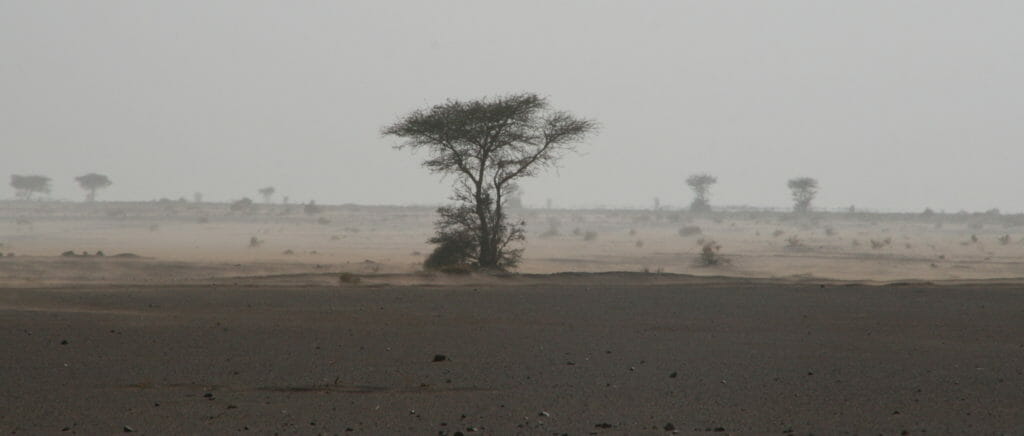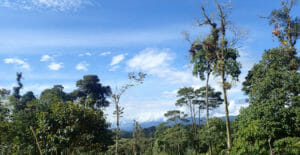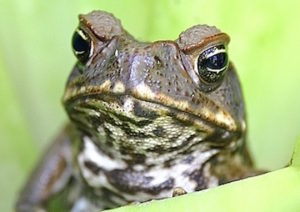Researchers Detect Light From Growing Plants
Invisible flickering from living vegetation detected by satellite could help scientists better assess how the exploitation of fossil fuels affects the climate. Even trees like these in the Sahara emit telltale light. (tuarek / Wikimedia Commons)
Even trees like these in the Sahara emit telltale light. (tuarek / Wikimedia Commons)
For the first time, light from plant growth may let humans see – almost at a glance – how greedily the planet’s vegetation sucks carbon dioxide from the atmosphere.
US-based researchers have confirmed that they can detect the same glow – invisible to the human eye – from trees, grasslands, crops, mangroves, marches and desert plants as the green things put chlorophyll to work and photosynthesise leaves, flowers, fruits and roots from atmospheric carbon.
The pay-off is simple: an easier and potentially more accurate way of calculating the global carbon budget and assessing the climate cost of human exploitation of fossil fuels.
But the same information will help biologists and geoscientists advance what is sometimes called earth system science: how carbon-based lifeforms make their living from sunlight, water and carbon dioxide in a continuous trafficking that has fuelled 3bn years of evolution.
And at the heart of the study is a new realisation that images from an orbiting satellite deliver better information in a reliable fashion.
Researchers have exploited data from orbiting earth observation satellites to measure the diminishing thickness of the polar ice caps and their dwindling extent, as human-induced global warming warms the oceans and raises the sea levels.
They have helped measure the response of different kinds of forest to global warming, and changes to ocean chemistry as ever greater levels of greenhouse gas enter the atmosphere, as humans burn ever more fossil fuels.
But one satellite, launched specifically to answer questions about the traffic between living things and the carbon dioxide in the atmosphere, has delivered information with even greater precision that anyone expected.
Researchers from the University of New Hampshire report in the journal Global Change Biology that years of observation of solar-induced fluorescence – a glow from plants that no human could expect to see, but an instrument can detect – have confirmed that there is a direct relationship between gross primary productivity and the amount of fluorescence registered by the eye in the sky.
No Exceptions
It means that what is true for the canopy of tropical forests in the Congo would also be true for a landscape of maize in the American mid-West, or the grasses and wildflowers of the savannah, the dusty maquis of the Mediterranean, or the swamps of the Louisiana bayous.
Up till now, researchers have tried to make accurate and reliable estimates on the ground, playing with air temperature, sunlight, rainfall and other factors to arrive at their conclusions about what they like to call carbon “sinks.” The message from OCO-2, the NASA orbiting carbon observatory, is that the gleam from the foliage below provides an answer more swiftly, and perhaps more surely.
“The importance of these results is that rather than look at several different types of data and computer-based models from information collected on the ground to monitor plant photosynthesis across the globe, using the satellite observations will provide a near real-time option that is simple, reliable and fast,” said Jingfeng Xiao, of the University of New Hampshire, the chief investigator.
“This is a big step towards being able to solely rely on satellite measurements.”
Your support matters…Independent journalism is under threat and overshadowed by heavily funded mainstream media.
You can help level the playing field. Become a member.
Your tax-deductible contribution keeps us digging beneath the headlines to give you thought-provoking, investigative reporting and analysis that unearths what's really happening- without compromise.
Give today to support our courageous, independent journalists.






You need to be a supporter to comment.
There are currently no responses to this article.
Be the first to respond.